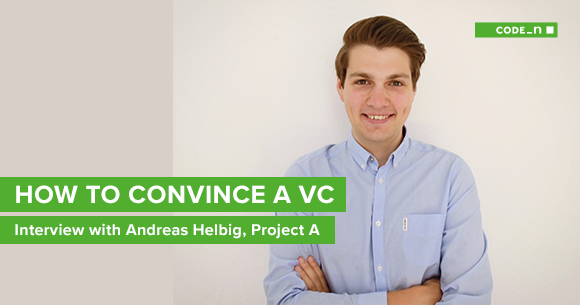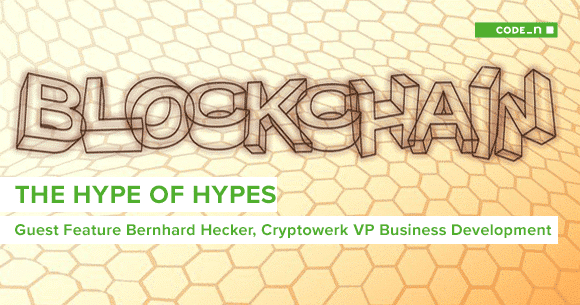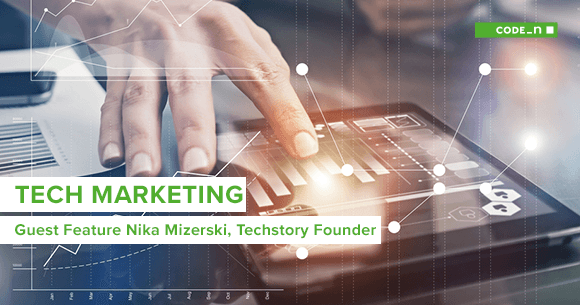“VCs enjoy a relaxed conversation too”, says Andreas Helbig from Project A
Startups watch out. Today, we’re switching sides. Look forward to an exciting interview with VC Andreas Helbig from the Berlin-based venture capital firm Project A. Andreas has already revealed during his talk at the GFT Inspiration Day on July 29th, 2017, that Project A is looking to step up its activities in southern Germany in the future. After all, in addition to digital health, financial technology, insurance technology, and new business models in the field of real estate brokering, B2B platforms and Industry 4.0 are now also the focus of investment for Project A. Today, Andreas reports in his capacity as VC from the other side of the “game”, and tells us what No-Gos startups absolutely need to avoid on the pitch deck, and what VCs really value. He also provides tips on how you can successfully gain access to investors, and what to do when the big moment arrives: With this insider knowledge, you’re guaranteed to make a good impression on your next pitch!

Lisa: Hi Andreas! First of all, thanks for the exciting talk you gave at the GFT Inspiration Day, as well as the VC advice to our residents in the Office Hour before. So can you give our readers a quick summary of what Project A offers to startups?
Andreas: Thank you for asking. We offer not only funding, but in fact also lots of other benefits for startups. First and foremost, of course, we’re a VC and we offer investment. Alongside this, however, we also offer operational expertise and manpower. We currently have a pool of approximately 100 experts. They come from various backgrounds, including sales, marketing, business intelligence and also data science. We also offer the teams access to developers, recruiters, specialists in communications or product management, and all at cost price.
Lisa: That’s quite a lot, in addition to financing.
Andreas: Yes. The experts are our permanent employees and work on a project basis for our Ventures portfolio. The additional services are optional. We get together with the founders and they then decide whether they want to take up our offer of support or not. And if the founder says, “Hey, we urgently need a project engineer for the next two months on a project basis for a redesign, but only 50%,” then we’ll try to organize it. As I already mentioned, we offer our ventures the services at cost price. In specific terms, this means that the salary and ancillary wage costs are broken down into an hourly rate. As a result, the startups get fast assistance that serves their requirements at a fair price.
Lisa: How well are your services received?
Andreas: Very well indeed. We’re not an agency in disguise, trying to get its people into their company at any cost. Instead, we’re a venture capital firm that regards itself as an enabler, helping to support its VC partners to scale themselves successfully. We simply have extremely good people who we know are able to give a startup the right push. This is something that founders really value, and our services are very well received.
Lisa: According to your own statements, you invest in startups across a range of industries. But is there perhaps one particular sector at the moment that has particularly caught your eye?
Andreas: Yes. As a former industrial engineer, I am naturally very interested in topics relating to Industry 4.0. We’ve realized, however, that the German SME sector is highly innovative. So for external startups, getting a foothold in this sector is pretty difficult. So far in Germany, the founder culture has not been widespread enough for an engineer from TRUMPF, for example, or Daimler, to sit down and say, “Hey, I’ve got an idea. I’ll set up my own business!”. We haven’t had this culture until recently. It’s only now that we’re slowly experiencing this change and we’re seeing a huge number of exciting new solutions both on the software and the hardware side. So we are currently looking more closely at Industry 4.0 solutions. Of course, fundamental technologies such as AI which includes machine learning are very exciting right now.
Lisa: What would you recommend to startup founders who are currently looking for funding?
Andreas: What would I recommend to startup founders? First of all, build a good product!
Lisa: Yes, that’s certainly an important first step ☺.
Andreas: Yes, a fundamental one. The product and product vision need to impress and inspire us. In an ideal situation, the startup should already have attracted some attention on the market with its idea so that the idea is being accepted. So it’s important for any startup to first do its homework. This is a fundamental requirement for reaching the first round of funding. What’s more, even if it’s, unfortunately, a little unfair, when you’re on the hunt for investors, some of the work involves a network. If a startup isn’t so well networked yet, then I suggest going to events, keeping an ear to the ground regionally, meeting people and slowly building up your network that way. If you want to take a more systematic approach, a list of contacts at venture capital funds and business angels is worth looking over, as well as career networks such as LinkedIn, to see whether there are any shared contacts who might be able to provide an introduction to the VC. Cold calling scarcely ever works. VCs get so many requests every day that recommendations via a personal contact acts as a sort of filter, and is therefore super-important.
Prior to #GFTinspires#event@ProjectAcom took the time 4 an individual #officehour for our #startup residents. Thanks a lot 4 the feedback pic.twitter.com/9Y9ZJXRciY
— CODE_n (@CODE_n) June 29, 2017
Lisa: So without a recommendation, finding an investor is hard? Are you saying you really have to impress to get an invitation?
Andreas: Of course, we look at all applications, without question. However, we do have a different perspective of startups that have been recommended to us personally.
Lisa: Do you have any tips or perhaps No-Gos for the pitch deck that founders should really be aware of?
Andreas: There are some. In this case, I would refer to the blog article in which we have summarized all of the key points. Essentially, you certainly need to avoid major blunders on the pitch deck. You should also forget cheap tricks such as presenting figures in a bamboozling way and prettifying your turnover by starting the Y-axis at Euro 30,000 and ending it at Euro 32,000, making your growth look very steep. We do notice these things, you know ;). And if things are described in a cryptic manner, we become skeptical. It’s important for founders to be able to sum up their idea. That also applies to figures. If I have to ask 50 times questions like, “So where are you currently?”, then I’m naturally not going to be impressed. A pitch deck should generate initial interest. It also needs to be well-structured so that I can quickly take a look at all of the key parameters again after the pitch. As investment managers, we’re also the startup’s advocate for future partnerships. We will often meet up in person and also pitch for the startup among our partners. Everything has to fit perfectly. The first conversation is with a representative of Project A. This person then presents the idea internally. Of course, there will be critical questions to answer. If we’re able to answer these questions with information in the pitch deck, then that’s always good. I also recently read the recommendation by Mark Suster, entrepreneur and investor at Upfront Ventures, that the first slide doesn’t necessarily have to feature the product or the vision, but rather the team. And I agree.
Lisa: So the presentation should focus more on the team and less on the product?
Andreas: Quite simply, the team is extremely important. This is why it should come right at the start if there is any doubt at all. And if you think about a typical investors’ meeting, then it also fits best in the storyline. The first thing you do is introduce yourself personally. Then you can start with the first slide and at the same time answer the question, “Why is this team bringing this thing to the market?”.
Lisa: Are we seeing a trend away from the business idea and product towards the team?
Andreas: I wouldn’t call it a trend away, but rather it is simply bringing something that is a strong success factor for startups more into focus. The team. If the revelation only comes at the end that the founders worked for 10 years as development engineers at Audi and are building software for a specific problem, then the penny drops in that precise moment and everyone thinks: “Yes, of course they can. They’ve understood the problem!”. It is also perfectly possible, however, for 20 minutes to pass during which everyone thinks, “Why should we believe that they can solve this problem? Why do they have any idea whatsoever about this complex issue?”
Lisa: Interesting. Are you able to offer founders any other tips on how to impress a VC?
Andreas: Some founders are clearly afraid of the pitch. Ultimately, we’re all in this business because we find innovations cool and because we’re passionate about and inspired by them. If you’re nervous, then it’s highly likely that you won’t be able to communicate that passion. And in the meeting, that can cause difficulties. We’re actually really nice – at least I think we are ;). And we’re only human. So don’t be afraid of us – be relaxed and at ease.
Lisa: OK, so the attitude and the first impression count.
Andreas: Yes, the personal fit is important for us. If the founders approach the pitch with a “lions’ den” logic and think: “Oh God, I’m the little startup and I’m going to be ripped apart”, then that naturally puts them under pressure. But these fears are unfounded. Of course, we’re going to ask questions, and sometimes we also ask stupid questions. But we’re simply trying to understand the business and develop excitement for it. We really enjoy a good conversation.
Lisa: So, dear founders, stay relaxed and show your passion. That’s a great way to end this interview. Thanks Andy for your insights and tips as a VC! We look forward to speaking with you soon!





Write a comment